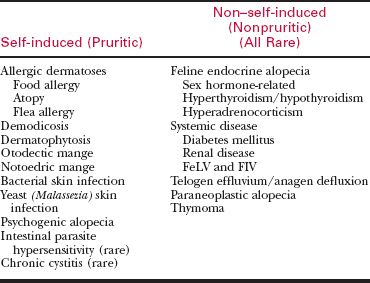Chapter 52 Feline Symmetrical Alopecia
Alopecia is defined as the absence of hair from skin areas where it is normally present. Feline symmetric alopecia (FSA) is a cutaneous reaction pattern with many possible etiologies; FSA should not be a final diagnosis, and it is important to determine the primary cause for the most appropriate therapy to be instituted.
ETIOLOGY OF ALOPECIA
Multiple factors play a role in normal hair follicle development and growth (Table 52-1). Absence or changes in one or more of the factors can alter the normal hair growth process and result in alopecia. The underlying causes of FSA can vary depending on the area or region of the body affected. This chapter focuses on the causes of FSA that are primarily confined to the trunk (dorsum, perineum, caudal thighs, flanks, ventral abdomen, and thorax). The underlying causes of FSA affecting the trunk region have been classified into those that are associated with self-trauma or pruritus (e.g., licking or scratching) and those that are nonpruritic (Table 52-2).
Table 52-1 INTERNAL AND EXTERNAL FACTORS INFLUENCING HAIR FOLLICLE GROWTH AND DEVELOPMENT
| Internal Factors | External Factors |
|---|---|
| Genetic | Nutritional |
| Hormonal | Infectious |
| Immunologic | Bacterial |
| Neoplastic | Fungal (dermatophytes) |
| Stress | Parasitic |
| Physical (traumatic) | |
| Chemical (toxins, drug therapy) |
Self-induced (Pruritic) Alopecia
Allergic dermatitis and parasitic infestations are the most common causes of self-induced alopecia. Other cutaneous reaction patterns associated with allergic and parasitic dermatoses are feline miliary dermatitis (see Chapter 53) and eosinophilic granuloma complex lesions (see Chapter 53). Allergic causes of self-induced alopecia in cats typically do not have as strong a regional distribution (i.e., involvement of specific body locations) as is the case in dogs.
Flea Infestation and Flea Allergy Dermatitis
When associated with mild pruritus and minimal dermatitis, fleas can cause a symmetric alopecia of the dorsum, proximal tail, flanks, perineum, and ventral abdomen. Although a similar presentation can be seen in cats with flea allergy dermatitis, the alopecia and pruritus are much more severe in flea-allergic cats, and they typically have concurrent skin lesions (miliary dermatitis) along the dorsum, tail base, and ventral abdomen (see Chapter 45). Some flea-allergic cats do not have involvement of the typical body locations as mentioned; other body locations maybe involved, and flea allergy dermatitis should remain a differential diagnosis for cats with pruritus and alopecia even if the typical body locations are not involved.
Food Allergy
Food allergy in cats is associated with non-seasonal pruritus and a variety of clinical presentations, including FSA. The skin lesions and severe pruritus may be generalized or confined to the face and ears or trunk. Alopecia, whether diffuse or symmetric, results from excessive pruritus triggered by an allergic reaction to specific food items ingested (see Chapter 47). Stubbled or broken hairs, with or without concurrent focal erythema, papules, and crusting (miliary dermatitis), are usually present. Food allergy should be considered a differential diagnosis in any cat with non-seasonal pruritus and alopecia.
Feline Atopic Dermatitis
Atopic dermatitis in cats may be associated with seasonal or non-seasonal alopecia and pruritus (see Chapter 46). Similar to that seen in feline food allergy, the alopecia is secondary to pruritus and is associated with broken or stubbled hairs and concurrent skin lesions. The alopecia may be generalized or confined to the head and neck or distal extremities. Food allergy and atopic dermatitis are virtually indistinguishable on clinical examination in cats with non-seasonal pruritus.
Dermatophytosis
This is a common cause of localized or generalized alopecia in cats (see Chapter 42). Fungal organisms invade the hair shaft and grow downward but do not penetrate the mitotic region of the hair. Alopecia is not permanent unless the follicle is destroyed by secondary inflammation. A wide spectrum of clinical presentations can be seen with feline dermatophytosis, including the asymptomatic carrier state, particularly in longhaired cats. Classically, the alopecia is focal to diffuse with small numbers of fractured or stubbled hairs and mild epidermal erythema and scaling. The majority of dermatophyte infections in cats are caused by the zoophilic fungus Microsporum canis. Pruritus is variable in dermatophytosis and when present is typically mild and rarely moderate to severe.
Demodicosis
Demodicosis is an uncommon cause of alopecia in cats (see Chapter 43). The pathogenesis of feline demodicosis is reported to be similar to that described in the dog and caused by either Demodex cati (follicular mite) or Demodex gatoi (skin surface mite). D. cati is a normal inhabitant of feline skin, which under favorable conditions proliferates in hair follicles. Lesions consist of focal to diffuse alopecia, erythema, scaling, and crusts that may be localized and self-limiting or generalized. In some cases, these lesions may mimic feline endocrine alopecia. Generalized demodicosis due to D. cati infestation is usually associated with an underlying immunosuppressive disease, such as feline leukemia virus (FeLV), feline immunodeficiency virus (FIV), diabetes mellitus, or neoplasia.
Otodectic Mange
Otodectes mites are the most common cause of otitis externa in cats (see Chapter 59). Otodectic mites can live on the skin surface and infrequently cause a symmetric alopecia over the lower back and tail base. Concurrent otitis externa may or may not be present. The degree of pruritus is variable.




